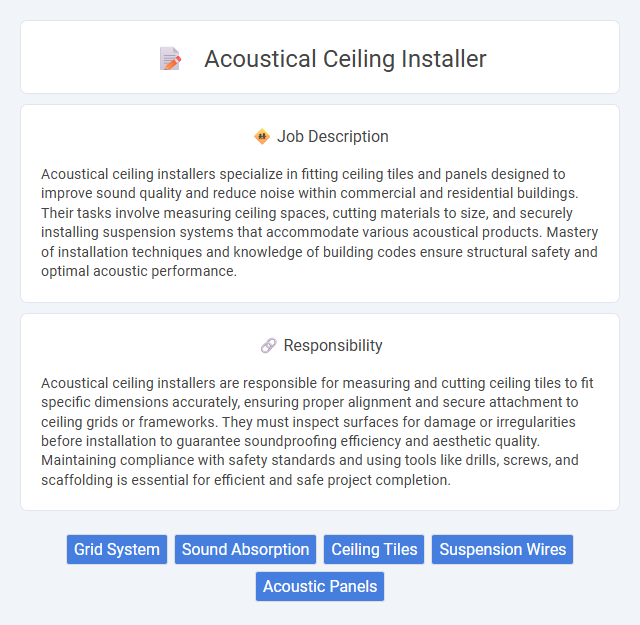
Acoustical ceiling installers specialize in fitting ceiling tiles and panels designed to improve sound quality and reduce noise within commercial and residential buildings. Their tasks involve measuring ceiling spaces, cutting materials to size, and securely installing suspension systems that accommodate various acoustical products. Mastery of installation techniques and knowledge of building codes ensure structural safety and optimal acoustic performance.
Individuals with good physical condition and stamina are likely suitable for an acoustical ceiling installer job, as it often requires lifting, climbing, and working in confined spaces. People who have a tolerance for working at heights and possess manual dexterity may be better adapted to handle the technical demands of this role. Those with respiratory issues or an aversion to working overhead might find this job less suitable due to potential exposure to dust and prolonged upward positioning.
Qualification
Acoustical ceiling installers must possess skills in measuring, cutting, and fitting ceiling tiles accurately to ensure sound absorption and aesthetic appeal. Essential qualifications include knowledge of building codes, safety regulations, and experience with tools such as drills, hammers, and laser levels. Physical stamina and attention to detail are critical for working at heights and maintaining precise alignment in suspension systems.
Responsibility
Acoustical ceiling installers are responsible for measuring and cutting ceiling tiles to fit specific dimensions accurately, ensuring proper alignment and secure attachment to ceiling grids or frameworks. They must inspect surfaces for damage or irregularities before installation to guarantee soundproofing efficiency and aesthetic quality. Maintaining compliance with safety standards and using tools like drills, screws, and scaffolding is essential for efficient and safe project completion.
Benefit
Acoustical ceiling installers likely experience benefits such as steady employment opportunities due to ongoing construction and renovation projects. They may also enjoy working environments that provide a sense of accomplishment from improving building aesthetics and sound quality. Enhanced skills in installation techniques could increase their job security and potential for higher wages over time.
Challenge
Acoustical ceiling installer roles likely involve complex challenges such as working in confined spaces and ensuring precise alignment of ceiling tiles for optimal soundproofing. Navigating irregular ceiling structures or dealing with outdated building conditions may increase job difficulty. The necessity for both physical stamina and meticulous attention to detail probably elevates the overall challenge of the position.
Career Advancement
Acoustical ceiling installers can advance their careers by gaining expertise in specialized materials and complex installation techniques, leading to roles such as project supervisor or estimator. Mastery of safety regulations and local building codes enhances opportunities for leadership positions within construction firms. Pursuing certifications in acoustical systems and construction management further increases earning potential and job market competitiveness.
Key Terms
Grid System
Acoustical ceiling installers specialize in assembling and securing suspended grid systems that support ceiling tiles in commercial and residential spaces. Expertise in measuring, aligning, and fastening metal grid components ensures precise installation and optimal acoustic performance. Mastery of grid system layouts directly impacts ceiling stability, sound absorption efficiency, and overall aesthetic quality.
Sound Absorption
Acoustical ceiling installers specialize in fitting ceiling systems designed to enhance sound absorption properties, significantly reducing noise levels in commercial and residential buildings. Their expertise in selecting and positioning materials such as mineral fiber tiles or perforated panels ensures optimal acoustic performance. Proper installation of these systems contributes to improved speech clarity and overall acoustic comfort in workspaces, schools, and auditoriums.
Ceiling Tiles
Acoustical ceiling installers specialize in the precise installation of ceiling tiles designed to enhance sound absorption and improve indoor acoustics in commercial and residential spaces. Mastery in handling various materials such as mineral fiber, fiberglass, and metal tiles ensures optimal performance and aesthetic appeal of suspended ceiling systems. Technicians assess ceiling grid layouts, cut tiles to fit unique dimensions, and secure them efficiently to create uniform, sound-dampening ceiling surfaces that comply with building codes and safety standards.
Suspension Wires
Suspension wires are critical components in acoustical ceiling installation, providing essential support for ceiling grids and tiles. Proper tension and secure attachment of suspension wires ensure the ceiling system maintains stability and alignment over time. Skilled installers must accurately measure, cut, and fasten suspension wires to meet building codes and safety standards.
Acoustic Panels
Acoustical ceiling installers specialize in the precise placement and secure mounting of acoustic panels to enhance sound absorption and reduce noise levels in commercial and residential spaces. Expertise in handling various panel materials like fiberglass, foam, and mineral fiber ensures optimal acoustical performance and aesthetic appeal. Proficiency in measuring, cutting, and fitting panels according to architectural specifications is crucial for effective noise control and improved room acoustics.
 kuljobs.com
kuljobs.com